Print Server
User’s
Manual

1.4 Network Printing Architecture
1.5 Network Printing Environment
1.6 Contents of the User’s Manual
1.7 Firmware & Printing Function
3. Windows Peer-to-Peer Network
3.2 Administrator Installation and Setup
3.4 Client Installation and Setup
4.2 Windows NT/2000 Server Installation and Setup
4.3 User Installation and Setup
5.2 NetWare 3.x Installation & Setup
5.3 NetWare 4.x/5.x Installation & Setup
6.2 Enable Print Server’s TCP/IP Support
6.3 Setup Print Server’s IP Address
6.4 Verify Print Server’s IP Address
6.5 Configure Remote lpd Printing on the Host
7.2 General - General Information of Print Server
7.4 Printer Status - Attached Printer Status
7.5 IP Cfg - IP Address Configuration
7.6 NW PS Cfg - NetWare Print Server
Configuration
7.7 NW RP Cfg - NetWare Remote Printer
Configuration
7.8 NW Information - NetWare Printing Summary
7.9 Print Server Cfg – Print Server Network
Ability Setting
7.10 Restore Default - Restore to Default
7.11 Upgrade - Firmware Upgrade / Update
7.12 DHCP Cfg - DHCP Server Configure
7.13 DHCP Information - DHCP Information
7.14 Mail Print Cfg - Email Printing Setting
7.15 SNMP Cfg - SNMP Parameter Setting
8.3 Web Management of Print Server
1. Introduction
1.1 Product Introduction
Thank you for purchasing and using our print server. This print server allows your printer to become a shared device on the network. It offers printing flexibility and manageability on your Local Area Network at an extremely low cost and with an absolute minimum setup and maintenance required.
This print server provides a network port (10Mbps or 10/100Mbps Ethernet) and one or three printer's parallel ports. Please refer to the information of various types of print server in the following sections for more detailed explanation.
This print server supports IPX, TCP/IP, and NetBEUI protocols. It is the best network printing solutions for various common network operating systems; such as Windows 95/98/Me Peer-to-Peer Printing, Windows NT/2000, NetWare, Unix/Linux, etc.
With the help of Installation Wizard, you can easily and instantly complete the settings for your printing environment, and start enjoying the fantastic features provided by this print server.
In the following chapters, we will introduce in detail the printing features, installation methods, and system configuration for different network environments.
If you would like to set up and install print server quickly, please refer to the Quick Installation Guide that comes along with this print server.
1.2 Product Models
|
Model |
LAN |
10M |
10M |
10/100M |
10/100M |
10/100M |
10/100M |
|
Printer |
1 Port |
1 Port |
1 Port |
1 Port |
3 Port |
3 Port |
|
|
Case |
Plastic |
Plastic |
Metal |
Plastic |
Metal |
Plastic |
|
|
Hardware |
|
|
|
|
|
|
|
|
Size |
|
|
Palmtop |
|
Desktop |
Desktop |
|
|
Direct Attached |
Yes |
Yes |
No |
Yes |
No |
No |
|
|
Number of Printer Ports |
1 |
1 |
1 |
1 |
3 |
3 |
|
|
Printer Connector |
Centronics |
Centronics |
DB25 |
Centronics |
DB25 |
DB25 |
|
|
Network Speed |
10M |
10M |
10/100M |
10/100M |
10/100M |
10/100M |
|
|
Network Connector |
UTP |
UTP/BNC |
UTP |
UTP |
UTP |
UTP |
|
|
Bi-Directional |
No |
No |
Yes |
Yes |
Yes |
Yes |
|
|
Flash Memory Size |
512K |
512K |
512K |
512K |
512K |
512K |
|
|
Network LED |
Yes |
Yes |
Yes |
Yes |
Yes |
Yes |
|
|
Status LED |
Yes |
Yes |
Yes |
Yes |
Yes |
Yes |
|
|
Firmware Upgrade |
Yes |
Yes |
Yes |
Yes |
Yes |
Yes |
|
|
Power-On-Self-Test |
Yes |
Yes |
Yes |
Yes |
Yes |
Yes |
|
|
Network Protocol Support |
|
|
|
|
|
|
|
|
IPX/SPX |
Yes |
Yes |
Yes |
Yes |
Yes |
Yes |
|
|
TCP/IP |
Yes |
Yes |
Yes |
Yes |
Yes |
Yes |
|
|
NetBEUI |
Yes |
Yes |
Yes |
Yes |
Yes |
Yes |
|
|
Network Environment |
|
|
|
|
|
|
|
|
Windows Peer-to-Peer Printing |
Yes |
Yes |
Yes |
Yes |
Yes |
Yes |
|
|
Windows Server-Based Printing |
Yes |
Yes |
Yes |
Yes |
Yes |
Yes |
|
|
NetWare Bindary Mode Printing |
Yes |
Yes |
Yes |
Yes |
Yes |
Yes |
|
|
NetWare NDS Mode Printing |
Yes |
Yes |
Yes |
Yes |
Yes |
Yes |
|
|
NetWare Remote Printer |
Yes |
Yes |
Yes |
Yes |
No |
No |
|
|
TCP/IP Remote Printing |
Yes |
Yes |
Yes |
Yes |
Yes |
Yes |
|
|
Unix LPR Printing |
Yes |
Yes |
Yes |
Yes |
Yes |
Yes |
|
|
Administration |
|
|
|
|
|
|
|
|
Windows Configuration Utility |
Yes |
Yes |
Yes |
Yes |
Yes |
Yes |
|
|
Web Management Server |
Yes |
Yes |
Yes |
Yes |
Yes |
Yes |
|
|
Web Management Utility |
Web
Manager |
Web
Manager |
Web
Manager |
Web
Manager |
Web
Manager |
Web
Manager |
|
|
SNMP Protocol |
Yes |
Yes |
Yes |
Yes |
Yes |
Yes |
|
|
Printer Port Management |
Yes |
Yes |
Yes |
Yes |
Yes |
Yes |
|
|
IP Assignment |
|
|
|
|
|
|
|
|
ARP & Ping |
Yes |
Yes |
Yes |
Yes |
Yes |
Yes |
|
|
DHCP Server |
Yes |
Yes |
Yes |
Yes |
Yes |
Yes |
|
|
DHCP Client |
Yes |
Yes |
Yes |
Yes |
Yes |
Yes |
|
|
BOOTP |
Yes |
Yes |
Yes |
Yes |
Yes |
Yes |
|
|
RARP |
Yes |
Yes |
Yes |
Yes |
Yes |
Yes |
|
|
DOS Utility |
Yes |
Yes |
Yes |
Yes |
Yes |
Yes |
|
|
Others |
|
|
|
|
|
|
|
|
Email Printing |
Yes |
Yes |
Yes |
Yes |
Yes |
Yes |
|
|
Direct Print |
Yes |
Yes |
Yes |
Yes |
Yes |
Yes |
|
|
Logical Printer |
Yes |
Yes |
Yes |
Yes |
Yes |
Yes |
|
|
Language |
English Chinese |
English Chinese |
English Chinese |
English Chinese |
English Chinese |
English Chinese |
|
|
CD-ROM |
Yes |
Yes |
Yes |
Yes |
Yes |
Yes |
|
1.3 Product Package
This package contains the following components:
q Print Server x 1
q Power Adapter x 1
q CD x 1
q Quick Installation Guide x 1
1.4 Network Printing Architecture
This section illustrates how print server functions and operates on the network. Before you install and use print server, it is strongly suggested that you read this section completely, and select only the chapters you need according to your network operating system by “Contents of the User’s Manual” in next section.
This section will first introduce the role every component plays in the network-printing environment.
l
Print Server
l
Client User
l
Network Server (optional)

Detailed examples will then be illustrated through actual network environment.
1.4.1 Print Server Network Functions

Because print server supports IPX, TCP/IP, and NetBEUI network protocols, any networked computer can directly print to the print server from any of its installed protocol.

1.4.2 Network Printing Functions for Clients

Common operating systems for clients are classified as following:
l
Windows 95/98/Me/NT/2000
q Our print server system provides PTPP (Peer-to-Peer Printing) driver and utilities for Windows 95/98/NT/2000 users. PTPP (Peer-to-Peer Printing) supports IPX, TCP/IP, and NetBEUI protocols. While printing after installation, PTPP will automatically select the proper transport protocol to connect to the print server depending on the protocols installed in each computer (client computer may only have IPX or TCP/IP installed).

q In the client installation procedure, after PTPP (Peer-to-Peer Printing Driver) is installed into Windows, the system will automatically (manual configuration is also allowed) search through all the print servers on the network, and then add their printing ports into Windows’ printing port. (see below)

l
UNIX / Linux
q UNIX (include HP/UX, SCO Unix, SunOS, Solaris, Unixware DECUnix, IBM AIX and others) and Linux use the system-standard LPR to print to print server.
1.4.3 Network Printing Functions for Network Server

Common network servers are classified as following:
l
Windows NT/2000
q Our print server system provides PTPP (Peer-to-Peer Printing) driver and utilities for Windows NT/2000. After PTPP is installed, the server can directly print to print server. Adding this printing function into Windows NT/2000 Server allows print queue, user authority management, and many other advanced features to be used.
l
NetWare 3.x/4.x/5.x
q In NetWare environment, print server offers various printing modes like print queue, remote printer, etc.
1.5 Network Printing Environment
Common network environment are classified as following:
l
Windows Peer-to-Peer Network
Since both the print server and client’s PTPP driver fully support IPX, TCP/IP, and NetBEUI protocols, when printing, the PTPP driver will automatically search and match up the protocol for both client and print server’s sides.

l
Windows NT/2000 Network
Network printing function will become available after PTPP driver is installed into Windows NT/2000. Adding this printing function into Windows NT/2000 Server allows print queue, user authority management, and many other advanced features to be used.

l
NetWare Network (see below)
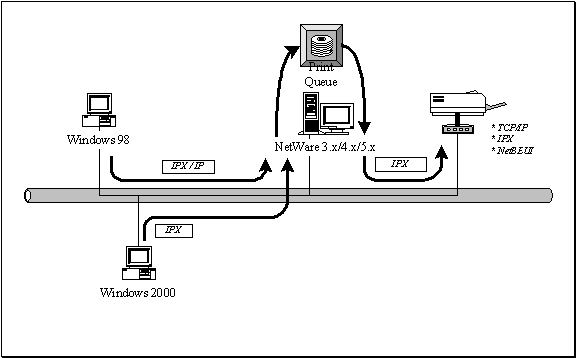
1.6 Contents of the User’s Manual
Chapter 2 explains print server’s hardware installation and configuration. It is strongly recommended for you to read.
The following chapters 3, 4, 5, and 6 introduces:
Chapter 3. Windows Peer-to-Peer Network
Chapter 4. Windows NT/2000 Server-Based Network
Chapter 5. NetWare Network
Chapter 6. UNIX System Network
You may select the appropriate chapters and sections to read depending on your network printing’s requirement.
Chapter
7 and chapter 8 introduce print server’s management and configuration utilities
on Windows and Web Browser’s environment respectively. You may select the
appropriate management utility according to the administrator’s computer
platform.
Chapter 9 introduces Print Server’s Email Printing function and setup procedure. The Email Printing provides a new way to print documents across the Internet by the Email.
1.7 Firmware & Printing Function
In order to provide a complete network printing solution, this print server supports Multiple Feature Sets function for users to select the appropriate Printing Feature Set to use depending on individual’s printing requirement. Currently, the system provides two Feature Sets for users to choose:
q Standard Feature Set
l PTPP (Peer-to-Peer-Printing)
q TCP/IP (LPR)
q NetBEUI
q IPX
l Email Printing
l NetWare Bindary Printing
q NetWare Enhancement Feature Set
l TCP/IP Printing (LPR)
l NetWare Bindary Printing
l NetWare NDS Printing
l NetWare Remote Printer
(Single Port print server Only)
All feature sets are included in print server’s CD.
<CD Driver>\FLASHROM\<Model Name>\PSxxROM.BIN
Please refer to section 7.11 for instructions on how to select and setup the Feature Set.
For example, if you need to use NetWare NDS Printing, then you must change the system’s default Standard Feature Set to the NetWare Enhancement Feature Set. In the meantime, print server will support NetWare NDS / Remote Printer and other printing functions; however, it will not support NetBEUI, Email Printing and other Standard Feature Set’s special functions.
2. Hardware Installation
1.
Unpack
the print server package and check all the items listed in section 1.3.
2.
Connect
the print server to the printer you want to share on the network
l For direct attach models, plug the
print server directly to the printer’s centronics port.
l For palmtop/desktop models, connect
the printer to print server by the standard printer cable.
3.
Connect
the power adapter to the print server.
4.
The
print server will perform the Power-On-Self-Test (POST) after it is powered on.
The Status LED will flash 6 times to indicate that the print server is ready.
NOTE1 : MUST use
the power adapter shipped with the print server, do NOT use any other power
adapter from any sources.
NOTE2: To prevent
the compatibility problem between print server and a few printer, it is
recommand that you power on the print server before the printer.
3. Windows Peer-to-Peer Network
3.1 System Architecture
Print server supports Windows Peer-to-Peer network printing mode, which is suitable for most medium and small network environments. Through quick and simple installation procedure, users can immediately enjoy the convenience of network printing.

Installation procedure is separated into following two parts:
1. Administrator Installation and Setup (refer to section 2 for more
detailed information).
System administrators must :
l
Install
administrator’s utilities into his/her computer.
l
Configure
print server from
administrator’s configuration utility.
2. Client Installation and Configuration (refer to section 3 for more
detailed information).
Client users must install Windows PTPP driver (Peer-to-Peer Printing) for network printing.
In addition, after PTPP is installed, the system will automatically search for all print servers on the network, and add all printing ports (P1/P2/P3) of the print servers into Windows’ printing port (refer to Network Printing Architecture in section 1.4 for more detailed information).
3.2 Administrator Installation and Setup
The Administrator Installation can be performed on Windows 95/98/Me/NT/2000 with the same user interface. Before the installation, please verify that your network protocol is installed on your PC ( TCP/IP, IPX and/or NetBEUI ). It will be helpful in your installation process.
1. Insert the CD shipped along with the print server into your CD-ROM drive. The Autorun.exe program should be executed automatically by Windows. If not, run Autorun.exe manually from CD-ROM drive’s root directory.
2.
The "Installation
Manager" will be displayed on the screen as following.

3.
Click “Administrator
Installation” and the “Utillities Setup” window will be displayed.

4.
Click “Next”, and specify the destination folder
where the utilities will be installed.

5.
Click “Next”,
and select the components you want to install. It is highly recommended to
install all provided components.

6.
Click “Next”,
and specify the program folder where the program icons will be added to.

7.
Click “Next”
to start installation.

8.
In a while,
the program will finish installing all the utilities and drivers you selected.
Thus far you have completed the installation phase and prepare to configure the
Print Server. Click “Next”, and the “Choose Print Server” dialog
box will be displayed as following.

NOTE: If this is the first time you configure the
print server, the “Print Server Name” is the same as the “Device Name” printed
at the rear side of the print server.
9.
Click “Next”,
and the “Name the print Server” dialog box will be displayed as
following,

You can assign a meaningful name for the management consideration. But note that, this name will be the “Identifier” for the Peer-to-Peer Printing (PTPP).
10.
Click “Next”
to configure network protocol in the following screen.

In the system default, IPX and NetBEUI protocols are enabled.
About the TCP/IP, you can either (1) assign a fixed IP address for the print server or (2) configure it later by the configuration utility.
11.
Click “Next”,
and the configuration summary is displayed in the window. Now, you have
completed the “Print Server Setup”. By clicking “Next” , your
system will perform “Add network port” of the print server to your PC.

12.
Finally,
the “Installation complete” window is displayed to indicate that the
Administrator Installation procedure is finished.

After the installation, you have completed the following tasks,
l Install all utilities and drivers to the administrator’s PC.
l Configure the print server (including the print server name and network protocol)
l Add the network port of the print server to the administrator’s PC.
Now, you have completed the administrator’s setup for most of the network environment. You can then perform the “Client Installation” procedure (section 3.4) on all client’s sides of the network.
If you want to print from this administrator’s PC to the print server, all you need to do is to perform Windows’ standard “Add Printer” procedure as described below.
Step1. Click “Start” button, choose Setting => Printers
Step2. Double click “Add New Printer”

Step3. Select “Local printer” => click “Next”.

Step4. Select a suitable printer manufacturer and model, then click “Next”.

Step5. Choose the “Print Server’s Network Port” which was created
by the administrator installation process and click “Next”.

Step6. Complete the rest of the questions to finish the network printer setup.
3.3 Administrator Utilities
After Administrator Installation is completed, there will be six utilities in print server’s Program folder.
l Network Ports Quick Setup
v Local printer port management tool (see section 3.5).
l Remote Ports
v Remote printer port management tool (see section 3.5).
l NetWare Quick Setup
v NetWare quick installation software (see chapter 5).
l Print Server Configuration
v Complete print server management tool (see chapter 7 –Print Server Configuration).
l Uninstall
v Assistant for removing all installed administrator software.
l Web Manager Administrator
v Web based management tool (see chapter 8 – Web Manager Configuration).
3.4 Client Installation and Setup
The Client Installation can be performed on Windows 95/98/Me/NT/2000 with the same user interface. Before the installation procedure, please confirm that your PC has connected to the network and installed at least one network protocol.
1. Insert the CD shipped along with the print server into your CD-ROM drive. The Autorun.exe program should be executed automatically by Windows. If not, run Autorun.exe manually from CD-ROM drive’s root directory.
2. The "Installation Manager" will be displayed on the screen as following.

3. Click “Client Installation”, and the “Utillities Setup” window will be displayed.

4. Click “Next”, and specify the destination folder where the utilities will be installed.
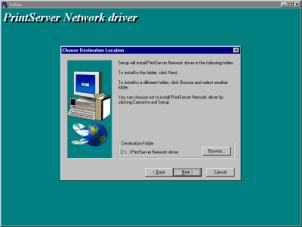
5. Click “Next”, and specify the program folder where the program icons will be added.

6. Click “Next” to start installation.

7. Now, the installation procedure is completed, and the next step is to set up the client’s computer. Click “Continue”, and all the print server’s network ports detected on the network will be added to your PC.

8. Finally, the “Installation complete” window is displayed to indicate that the Client Installation procedure is finished.
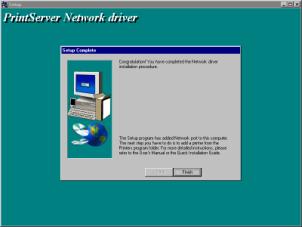
After the installation, you have completed the following tasks :
l Install all utilities and drivers to the client’s PC.
l Add all the print server’s network ports of the network to the client’s PC.
You can then perform the Windows’ standard “Add Printer” procedure as described below to add network printers to your PC.
Step1.
Click “Start”
button, choose Setting => Printers
Step2.
Double click “Add New
Printer”.

Step3.
Select Local printer
=> click Next.

Step4.
Select the suitable printer
manufacturer and model, then click Next.
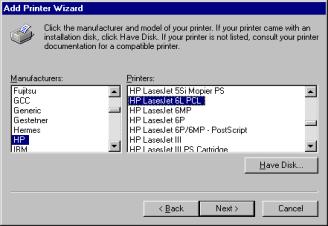
Step5.
Choose the print server’s
Network Port which has been created in the client installation process
and then click Next.
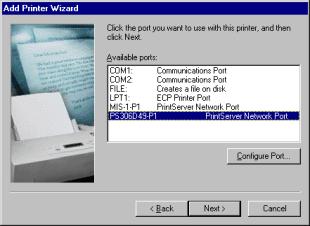
Step6.
Complete the rest of the
questions to finish the network printer setup.
3.5 Client Utilities
After Client Installation is completed, there will be three tools in print server’s Program folder.
l Network Ports Quick Setup
l Remote Ports
l Uninstall Network Driver
The Uninstall Network Driver will assist you in removing all installed client software. The other two tools are described as following:
3.5.1 Network Ports Quick Setup
Network Ports Quick Setup Utility offers a very simple method to add or remove print server’s printer port from the client’s computer.
During the client’s installation procedure, the system will automatically search for all print servers on the network,
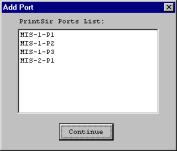
and add them into the printer ports of the client’s computer. (see below)
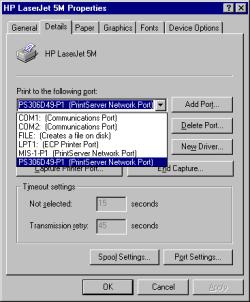
If you have just installed another new print server on the network, you must run this program first. This program will search for new print servers and allow you to add the new network printer port into client’s computer conveniently. Perform the standard Add Printer procedure, then you can print directly to the printer through the newly installed print server.
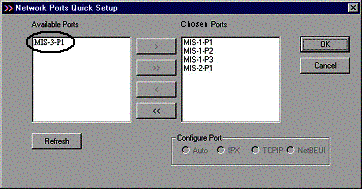

Please be aware that Network Ports Quick Setup Utility can only detect and configure all print servers on the same network, it cannot search and configure print servers on other subnets across network segments. You must use Remote Ports Utility described in the next section to manage remote (across network segments) print servers.
3.5.2 Remote Ports (Utility)
Remote Ports Utility offers a convenient way for you to manage and add printer port of the remote print server. From the assistant of this utility, you can print to other print servers outside the subnet across network segment. However, please note that this function only supports TCP/IP network protocol.
Please follow the procedures described below:
Step1.
Run Remote Ports Utility
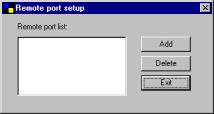
Step2.
Press Add, then enter the print
server’s name, IP address, and port number.

Step3.
Press OK to add the remote
printer port into your computer’s printer ports.
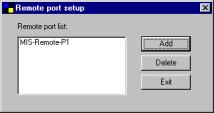
In order to use the remote printing function, you will have to proceed with normal Add Printer procedure and select your printer port as the newly added remote printer port.
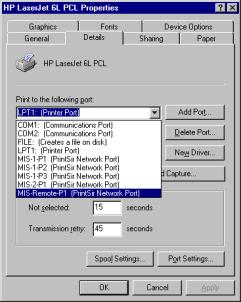
4. Windows NT/2000 Network
4.1 System Architecture
In Windows network environment, other than the Peer-to-Peer network printing architecture described in the previous chapter, we also offer the Server-Based Printing architecture for Windows NT/2000 server. Only one Windows NT/2000 is required to have Windows PTPP (Peer-to-Peer Printing) driver installed and share the printing service on the network. Other network users can simply connect to the server and access the shared printer. (see below)
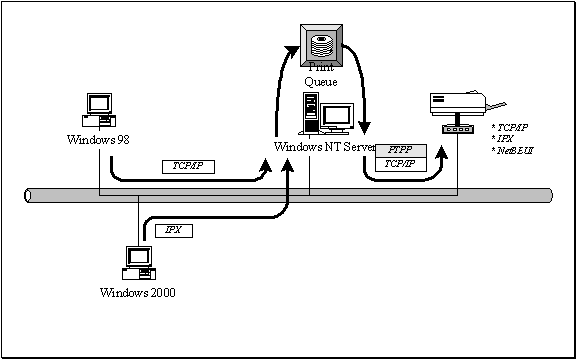
4.2 Windows NT/2000 Server Installation and Setup
Please follow the procedures described below for installation and construct a peer-to-peer connection (PTPP) between Windows NT/2000 Server and Print Server.
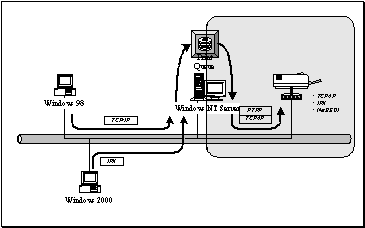
Step1.
If this is your first time installing print server, please install the administrator software on Windows NT/2000 server first. Refer to section 3.2 for installation instructions.
If your network has already installed a working print server and your Windows NT/2000 server has not yet installed the PTPP driver, please install the client software. Refer to section 3.4 and 3.5 for installation instructions.
Step2.
Please add/configure the Peer-to-Peer Printing of the Windows NT/2000 network printer and verify that you can print from Windows NT/2000 to the print server by the installed PTPP driver.
Step3.
Share the above server’s printer to the network by performing the standard Windows printer sharing process.
4.3 User Installation and Setup
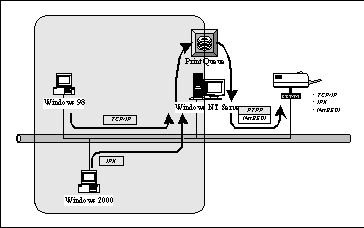
After server side’s installation is completed, client side will be able to find the server’s shared printer in Network Neighborhood. You only need to perform Window’s standard Add New Printer procedure, select “Network Printer” shown in the screen below, and complete the configurations afterwards to access the shared printer.
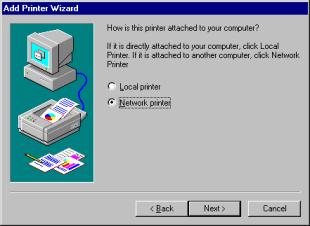
5. NetWare Network
5.1 System Architecture
We implement NetWare printer sharing functionality into the print server itself, thus allowing one or more printers attached by a print server to be connected to the network. We have developed the print server to support both NetWare print server and remote printer functions:
q Embedded print server, which emulates the “queue management functionality” of NetWare print server, PSERVER program running on the NetWare server. A user first prints a job at a workstation, the job is routed to a NetWare server, the NetWare server stores the job in a print queue, then the print server gets the print job from the queue to printers.

q Embedded remote printer, which allows a printer to function identically to a DOS workstation running NPRINTER.EXE program, but without the DOS workstation. A user first prints a job at a workstation, the job is routed to a NetWare server, the NetWare server stores the job in a print queue, then the print server moves the print job from the queue to the remote printer then to the printer.
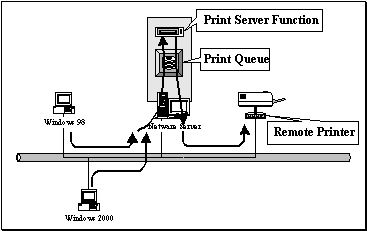
Compare with NetWare printing functionality, the advantages of embedding the NetWare network printing functionality in the print server include:
l Installation is easier and quicker.
l Network management is easier.
l Printing performance is enhanced.
l Relieve NetWare file server’s burden.
l Relieve the need of a workstation running the remote printer utility.
l Improve productivity by locating the printer near the workgroup.
The print server can operate either in print server mode or in remote printer mode. Each print server should log into a NetWare server before servicing the print jobs. Each print server will occupy a user account with which it can log into the NetWare server. A remote printer will not log into a NetWare server; it will connect to a NetWare print server and get the print jobs from the print server. A remote printer does not occupy any user account. A NetWare print server can control many remote printers; thus a print server account can be shared to many remote printers as your requirement. But the printing performance of a remote printer will be slower than a print server‘s, because a remote printer does not get a print job directly from the print queue, it gets a print job from the print server. Summarize the comparison between a print server and a remote printer as follows:
q The Advantage of
a Print Server
● Easy configuration.
● Better printing performance.
q The Advantage of
a Remote Printer
● Save user licenses.
NOTE: This remote printer feature is not
available for the 10/100Mbps 3-port models.
5.2 NetWare 3.x Installation & Setup
Please note that,you need install the IPX protocol before the following procedure,
1. On DOS environment or DOS box of Windows, use the “INSTALL” quick-installation program found on the <CD-ROM Drive>\DOSUTIL of CD-ROM included with the print server.
2. On DOS environment or DOS box of Windows, use the “PSETUP” configuration program found on the included <CD-ROM Drive>\DOSUTIL, configure the print server to use a particular file server. Then, use NetWare’s PCONSOLE program to create a NetWare print server and print queue with the appropriate names.
5.2.1 Quick Installation Using “Install” program
The INSTALL program included on the CD-ROM can be used to quickly set up the print server for use on the NetWare environment. It can only be used to set up the print server as Printer Server mode; it cannot be used to configure the print server as Remote Printer mode. It handles changing the print server’s internal settings, the creation of NetWare print server and print queue objects on the file server, and the assignment of the print server to the queue. Unless you need to configure the NetWare settings to conform to special requirements for your network, you can use the quick installation method.
To use this method,
1. Log into your NetWare server as SUPERVISOR.
2. Insert the CD-ROM included with the print server, and change to the appropriate drive and directory. Ex. e:\dosutil\
3. Run the INSTALL program

4.
Select your new print server from the
displayed list and press Enter.
The name listed will be the same as the Device Name printed on a label
on your print server.
5. A list of defaults will be displayed. If you need to change any of these items, use the arrow keys
to choose the item you need to change, then press Enter
to display a list of choices. When all of the values are correct, select the Continue Installation item and press
Enter.
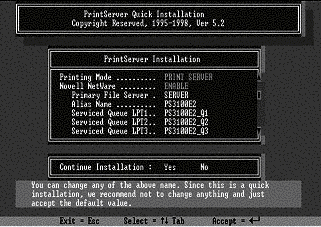
6.
The quick installation program will not
only set up the print server, but create and setup all required objects on the
file server. When the setup is complete, it will also display an execution
command as following that you can run after logging in to the file server to
redirect print commands to the new print server. :
capture
/S=III /Q=PRINTSERVER_Q1 /nt /nff /nb /l=1 /ti=10
This redirects the LPT1 port (/l=1) to the print queue PRINTSERVER_Q1 on the file server named III. No banner page will be printed (/nb), no form feed will be added to
the end of the job (/nff), and tabs will not be expanded into
spaces (/nt). If the program does not explicitly signal end-of-job, the capture
facility will wait 10 seconds (/ti=10) before assuming that the print
job is complete.
7.
Reset the print server to have the
changes take effect.
Before printing, you may want to verify that the setup was complete. Using the Print Server Status option of the PSETUP command (as described in the following section), you can verify that the print server is connected to the right file server, is using the correct network frame type, and so on.
You may also want to use the NetWare PCONSOLE program to verify that:
q A NetWare print server and one, two or three print queue(s) have been created on the file server. The number of print queues created is equal to the number of printer port of your print server.
q Printer 0 (or Printer 1, Printer 2) on the print server is serving the new print queue(s).
q The print queue(s) and print server have the right permissions and notification settings.
q For more detailed information, consult your NetWare manual.
5.2.2 Installation Using PSETUP
5.2.2.1 Configuring as Print Server Mode
For more complex setup needs, you can use the PSETUP program in conjunction with the NetWare PCONSOLE program.
The installation procedure is as follows:
1.
From a workstation, log in to your
NetWare server as SUPERVISOR.
2.
Run the PSETUP program included on the
CD-ROM. ( Ex. e:\dosutil\psetup.exe )
3.
Select your new print server from the
list provided.
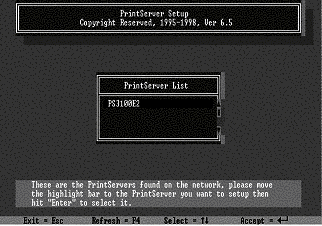
4.
Choose NetWare Configuration from the
menu.
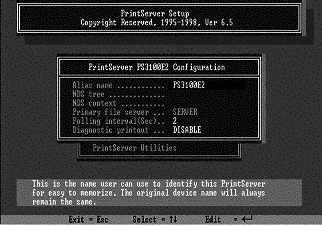
5.
Select Print server in the Printing
mode field.
6.
Change the Alias name if you want.
7.
Set the Primary File Server to be the
file server where the print server’s queue will be located.
8.
Press Escape to exit the Print Server
Configuration screen, confirm that the changes should be saved, and exit
PSETUP.
At this point the print
server setup is complete, and you can begin setting up the NetWare print server
and print queue objects:
9. Run the NetWare PCONSOLE program.
10. Change the current file server, if necessary, using the Change
Current File Server menu selection.
11. Choose the Print Queue Information menu selection.
12. Press the Insert key to add a new print queue.
13. Type in a print queue name, such as “PQ”
or “Q1”.

14. You have now successfully created the print queue that your print
server will serve. Press the
Escape key until the Available Options main menu is displayed.
15. Select Print Server Information.
16. Press the Insert key to add a new NetWare print server object. The
print server name can be identical to the PSxxxxxx name printed on the label of
the print server, or you can use an alias name you have assigned using PSETUP.
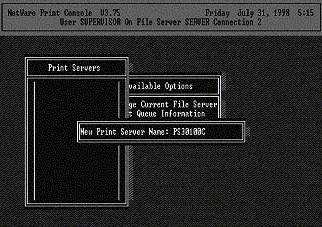
17. Press Enter to select the newly created print server.
18. Select Print Server Configuration.
19. Select Printer Configuration.
20. Select Printer 0 (or Printer 1, Printer 2), and press Enter, then
select Parallel LPT1 (or LPT2, LPT3) in the Type field. If your print server is
with only one port, you do not need to configure this Type field.
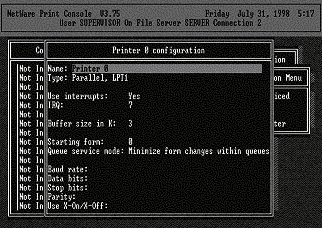
21. Press Escape, and answer Yes to the Save Changes question.
22. Select Queues Serviced by Printer, then select Printer 0 (or Printer
1, Printer 2) and press Enter.
23. Press Insert and add your newly created print queue to the list of queues serviced by the printer. Enter a priority number for the queue
service, or press Enter to accept the default.
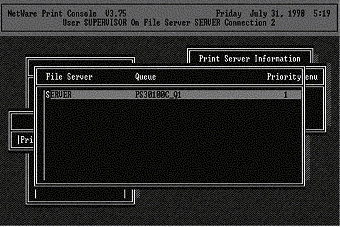
24. Repeatedly press Escape to exit the PCONSOLE program.
25. Reset the print server to have the changes take effect.
NOTE: If the print server you have is with multiple printer connectors, you may create multiple print queues and printer objects.
Your print server should now be ready to use. You should be able to redirect printing to your print server using a CAPTURE command such as the one shown in the previous section.
5.2.2.2 Configuring as Remote Printer Mode
This remote printer feature is not available for the 10/100Mbps 3-port print server models. Make sure that you have created the NetWare print server with Type Remote using PCONSOLE utility before you configure the print server. For more detailed information about PCONSOLE, please refer to NetWare’s manual. You can set up the NetWare print server and print queue objects by following the steps below:
1.
Run the NetWare PCONSOLE program.
2.
Change the current file server, if
necessary, using the Change Current File Server menu selection.
3.
Choose the Print Queue Information
menu selection.
4.
Press the Insert key to
add a new print queue.
5.
Type in a print queue name, such as “PQ”
or “Q1”.
6.
You have now successfully created the
print queue that your NetWare print server will serve. Press the Escape key
until the Available Options main menu is displayed.
7.
Select Print Server Information.
8.
Press the Insert key to
add a new NetWare print server.
9.
Press Enter to select
the newly created print server.
10. Select Print Server Configuration.
11. Select Printer Configuration.
12. Select Printer 0 (or Printer 1, Printer 2), press Enter,
and then select Remote Parallel in the Type field.
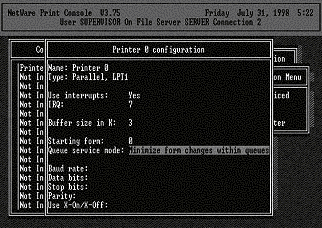
13. Press Escape, and answer Yes to the Save
Changes question.
14. Select Queues Serviced by Printer, then select Printer
0 and press Enter.
15. Press Insert and add your newly created print queue to
the list of queues serviced by the printer. Enter a priority number for the queue service, or press Enter
to accept the default.

16. Repeatedly press Escape to exit the PCONSOLE program.
17. You must load NetWare print server on the NetWare file server so
that the print server configured as a remote printer can connect to that print
server and service the print jobs. To load the NetWare print server, type “LOAD
PSERVER.NLM PrintServer” command at the system console of the
NetWare file server, where PrintServer is the print server name newly
created by the PCONSOLE program.
To configure the print server as a NetWare remote printer, perform the following steps:
1. From a workstation, log in to your NetWare server as SUPERVISOR.
2. Run the PSETUP program included on the CD-ROM. (ex. e:\dosutil\psetup.exe)
3. Select your new print server from the list provided.
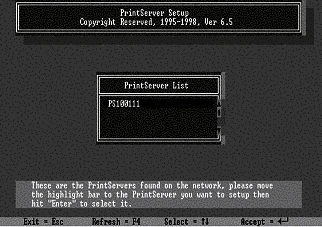
4. Choose NetWare Configuration from the menu.
5.
Select
Remote Printer in the Printing mode field.
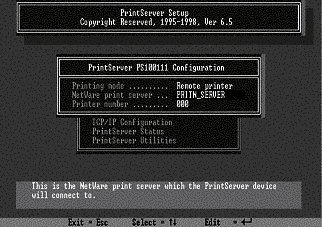
6.
Type
the print server‘s
name in the Print server field. The print server will be serviced
by the print server that is being configured as a remote
printer now.
7.
Type
the printer number assigned in PCONSOLE in the Printer Number
field.
8.
Press
Escape to exit the NetWare Configuration screen, confirm that the
changes should be saved, and exit PSETUP.
9.
At
this point the print server setup is complete.
10.
Reset
the print server to have the changes take effect.
5.3 NetWare 4.x/5.x Installation & Setup
This chapter tells how to configure your print server for operation with NetWare 4.x/5.x file servers and clients using NDS (NetWare Directory Services). If you need to install NetWare 4.x/5.x bindary mode network printing, please refer to the previous chapter. The installation procedure is the same as NetWare 3.x.
How
NetWare 4.x/5.x is Different
Novell NetWare version 3.x uses a database called the bindery for storing information such as user and group information, server configuration, and information about network services. Each NetWare 3.x file server has its own bindery, which is administrated separately from other file servers using commands such as SYSCON, PCONSOLE, and so on.
NetWare version 4.x/5.x improved on the bindery concept by introducing NDS, NetWare Directory Services. NDS is a tree-structured directory that is shared by a group of file servers on a network, allowing centralized administration and easy coordination of users, permissions, and resources between servers.
To make it possible for NetWare 4.x/5.x servers to coexist with NetWare 3.x servers, NetWare 4.x/5.x supports bindery emulation, which makes parts of the NDS directory visible to NetWare 3.x clients, just as if the information were stored in a NetWare 3.x bindery. This allows clients to access NetWare 4.x/5.x servers without being upgraded to the NetWare 4.x/5.x software, and for 3.x and 4.x/5.x servers to be mixed on a network.
Your print server can operate either in bindery mode or NDS mode. Bindery mode works with NetWare 3.x servers and with NetWare 4.x/5.x servers using bindery emulation. NDS mode works with NetWare 4.x/5.x servers.
NOTE : Though the
print server supports both bindery mode and NDS mode, it cannot support both at
the same time. If you are using both NetWare 3.x and 4.x/5.x servers, you need
to set up the print server to use bindery mode. If you need to install NetWare
4.x/5.x bindary mode network printing, please refer to the previous chapter.
The installation procedure is the same as NetWare 3.x.
5.3.1 Quick Installation Using “Install” program
The INSTALL program included on the CD-ROM can be used to quickly set up the print server for use. It can only be used to set up the print server as Server mode; it cannot be used to configure the print server as Remote Printer mode. To use this method,
1.
Log
in to your NetWare server as ADMIN.
2.
Insert
the CD-ROM and change to the appropriate drive and directory. Ex. e:\dosutil\
3.
Run
the INSTALL program with “NDS”
option.
E :\dosutil\install /NDS
4.
Choose
your new print server from the displayed list and press
Enter. The name listed will be the
same as the Device Name printed on a label at the your print
server.
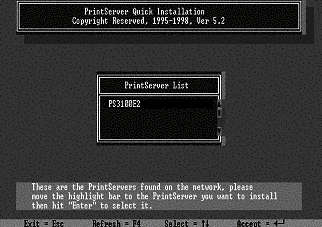
5.
A
list of defaults will be displayed.
If you need to change any of these items, use the arrow keys to choose
the item you need to change, then press Enter to display a list of choices.
When all of the values are correct, select the Continue Installation item and
press Enter.
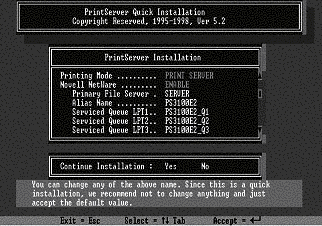
The Current Tree and Current Context settings cannot be changed within
the INSTALL program. If you need
to change the tree or context where the print server will be installed, use the CX
command to change them before starting INSTALL program.
6.
The
quick installation program will not only set up the print
server but create and setup all required objects on the network. When the setup is complete, it
will also display an execution command as following that you can run after
logging in to the file server to redirect print commands to the new print server.
7.
Reset
the print server to have the changes take effect.
NOTE: The print server may require up to a minute
after power-up to log into a NetWare Directory Services context because of the
large number of calculations NDS security requires.
5.3.2 NetWare 4.x/5.x Installation Using PSETUP
5.3.2.1 Configuring as Print Server Mode
For more complex setup needs, you can use the PSETUP program in conjunction with the NetWare PCONSOLE program.
To install the print server using NetWare Directory Services (NDS) mode,
1.
Log
in to your NetWare server as ADMIN.
2.
Run
the PSETUP program included on the print server CD-ROM. (ex. e:\dosutil\psetup.exe)
3.
Select
your new print server from the list provided.
4.
Choose
NetWare Configuration from the menu.
5.
Select
Print server in the Printing mode field.
6.
Change
Alias name if you want.
7.
Set
the NDS tree and NDS context where the print server will be located. Do NOT set a Primary file server, as
that would force the use of bindery mode.
8.
Press
Escape to exit the Print Server Configuration screen, confirm
that the changes should be saved, and exit PSETUP.
9.
Run
the NetWare PCONSOLE program.
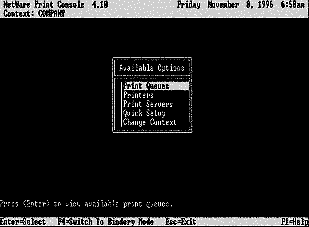
10.
Change
the current context, if necessary, using the Change Context menu
selection.
11.
Choose
Quick Setup from the menu.
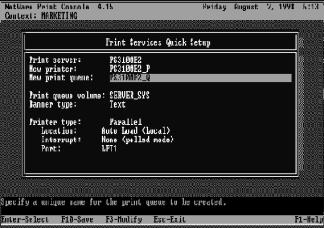
12.
Enter
the print server name (either the PSxxxxxx name or an alias
name you have assigned) in the Print server field.
13.
Assign
printer and print queue names.
14.
Set
the Banner type to PostScript if you are using a
PostScript printer, and to Text otherwise.
15.
Press
F10 to save the new configuration.
16.
Reset
the print server to have the changes take effect.
NOTE: The print server may require up to a minute
after power-up to log into a NetWare Directory Services context because of the
large number of calculations NDS security requires.
Your print server should now be ready for use by workstation users. You should be able to redirect printing to your print server using a CAPTURE command.
5.3.2.2 Configuring as Remote Printer Mode
This remote printer feature is not available for the 10/100Mbps 3-port models. Make sure that you have created the NetWare print server with Type Remote using PCONSOLE utility before you configure the print server. For more detailed information about PCONSOLE, please refer to NetWare‘s manual. You can set up the NetWare print server, print queue and printer objects by following the steps below:
1.
Run
the NetWare PCONSOLE program.
2.
Change
the current context, if necessary, using the Change Context menu
selection.
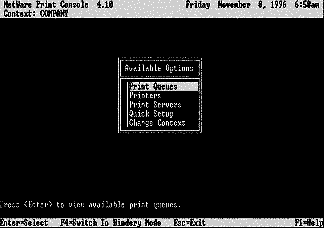
3.
Choose
Quick Setup from the menu.
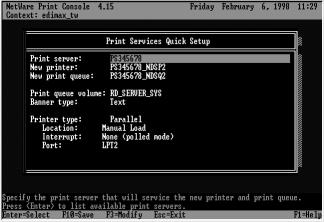
4.
Enter
the print server name in the Print server field.
5.
Assign
printer and print queue names.
6.
Set
the Banner type to PostScript if you are using a
PostScript printer, and to Text otherwise.
7.
Set
the Location to Manual Load.
8.
Press
F10 to save the new configuration and return to the main menu.
9.
Choose
Printers menu.
10.
Select
your newly created Printer from the Printers list.
11.
You
can view or edit the Printer number from 0 to 255.
12.
Save
the new configuration and exit PCONSOLE.
You must load NetWare print server on the NetWare file server so that the print server configured as a remote printer can connect to that print server and service the print jobs. To load the NetWare print server, type “LOAD PSERVER.NLM PrintServer” command at the system console of the NetWare file server, where PrintServer is the print server name newly created by the PCONSOLE program.
To configure the print server as a NetWare remote printer, perform the following steps:
1. Log in to your NetWare server as
ADMIN.
2. Run the PSETUP
program included on the CD-ROM. ex: e:\dosutil\psetup.exe
3. Select your new print server from the list provided.
4. Choose NetWare
Configuration from the menu.
5. Select Remote Printer
in the Printing mode field.
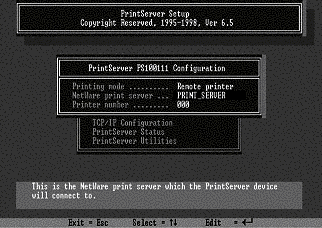
6. Type the print server‘s
name in the Print server field. The print server will be serviced
by the print server that is being configured as a remote
printer now.
7. Type the printer number assigned
in PCONSOLE in the Printer Number field.
8. Press Escape to
exit the NetWare Configuration screen, confirm that the changes should be
saved, and exit PSETUP.
9. Reset the print server to have the changes take effect.
6. UNIX System Network
6.1 Introduction
The print server is available for TCP/IP printing by Unix lpd (Line Printer Daemon) protocol. The lpd protocol originated with Unix release is based on the BSD version of Unix and supported under most versions of Unix.
This chapter explains how to configure the print server for TCP/IP operation, and how to modify configuration files on your Unix system to allow printing to the print server. The configuration examples in this manual follow the syntax for BSD based Unix systems. Please refer to the related system documentation for the correct syntax of your systems.
To configure the print server for lpd printing, perform the procedures below:
1.
Enable Print Server’s TCP/IP Support.
2.
Set up Print Server’s IP address.
3.
Verify Print Server’s IP Address.
4.
Configure remote lpd printing on the host.
5.
Print a test page.
In the next sections, we will describe these five procedures step by step.
6.2 Enable Print Server’s TCP/IP Support
The default configuration of the print server is with TCP/IP support enabled. Anyway, you can configure the print server to enable TCP/IP support using the configuration program or PSETUP program in the CD-ROM included with the Print server.
6.3 Setup Print Server’s IP Address
The print server must have a unique IP address in order to be recognized by the network.
You can set up the IP address on the various Unix systems using any one of the following methods:
1.
ARP & Ping Assignment (Recommand for Unix)
2.
DHCP (Dynamic Host Configuration Protocol)
3.
BOOTP (Bootstrap Protocol)
4.
RARP (Reverse Address Resolution Protocol)
The print server will use the last three methods to obtain its IP address automatically if its IP address is configured as Auto (0.0.0.0).
6.3.1 ARP & Ping Assignment
You can use ARP and Ping commands with a web browser to complete print server’s IP address setting.
Parameters for the commands are as follows:
arp –s <IP
Address> <Ethernet ID>
ping <IP
Address>
For example, a print server with the following configuration:
Node
ID: 0000B4010101
(the
Node ID is printed on the rear side of the print server)
Assign IP address:
203.66.191.12
arp –s
203.66.191.12 00-00-B4-01-01-01
ping
203.66.191.12
At the mean time, print server’s IP will “temporarily” be set to 203.66.191.12 (will restore after reboot). Therefore, you need to run your web browser to set a permanent IP address (refer to section 8.3.7 for detailed IP configuration).
6.3.2 DHCP
There are many Unix systems that support DHCP protocol, and the procedures to configure the DHCP server database are different. This manual does not describe the DHCP server configuration on the Unix systems. It is highly recommended that the DHCP server should be located on the same network as the print server.
6.3.3 BOOTP
If you have the BOOTP daemon, bootpd, running on your UNIX system that is accessible by the print server, you can use the BOOTP protocol to set up the IP address of the print server. We recommend that the BOOTP server should be located on the same subnet as the print server. If you use Network Information Services (NIS) in your system, you may need to rebuild the NIS map with the BOOTP services before doing the following BOOTP configuration. To rebuild the NIS map, please refer to your system documentation.
To configure the IP address data for the BOOTP server, you will need to log in the host of BOOTP server as the superuser (root). Perform the following steps to add address entries,
1.
Optionally,
assign a name corresponding to the print server’s IP address. You can add
this address to the /etc/hosts file, by adding a line such as:
203.66.191.12 pserver
2.
Add
an entry to the host’s /etc/bootptab file, similar to the
following:
hostname:\
:ht=1:\
:ha=print_server_ethernet_address:\
:ip=print_server_ip_address:
Lines should be indented with tabs.
Where hostname is the device name of a print server, the ht=1 tag specifies the hardware type is Ethernet, the ha= tag specifies the Ethernet address of a print server, which is the Node ID located on the print server. The ha tag must be preceded by the ht tag. The ip= tag should correspond to the IP address you want to assign to the print server.
For example, a print server with the following configuration:
Node ID: 0000B4010101 (this implies Ethernet
address is 0000B4010101),
IP address: 203.66.191.12
The entry for this print server in the /etc/bootptab file should be:
PS010101:\
:ht=1:\
:ha=0000B4010101:\
:ip=203.66.191.12:
6.3.4 RARP
The procedure below enables the RARP daemon running on your system to respond to a RARP request from the print server and to assign the IP address to the print server.
1.
Log
in the host of RARP server as the superuser (root).
2.
Assign
a name corresponding to the print server ’s IP
address. You can add this address
to the /etc/hosts file, by adding a line such as:
203.66.191.12 pserver
3.
Add
the Ethernet address and the host name for the print
server to the
/etc/ethers file, by adding a line such as:
00:00:B4:01:01:01 pserver
Where the Ethernet address of the print server is the Node ID located on the print server.
4.
If
your system uses Network Information Services (NIS), you will need to make
changes to the NIS host and ethers databases.
5.
Check
if the RARP daemon is running using the ps and grep commands. If the RARP
daemon is not running on your host, type “rarpd -a”
to run the RARP server.
6.4 Verify Print Server’s IP Address
To verify that your print server is responding to the newly assigned IP address using a PING command:
ping
ip-address
6.5 Configure Remote lpd Printing on the Host
The procedure you use to configure your Unix host(s) to allow printing to your network remote print server varies between different varieties of Unix. The procedure below can be used for Unix variants that are related to BSD Unix, such as SunOS or Linux. For other versions of Unix, consult your system documentation, keeping in mind that:
1.
The print server should be treated as a BSD networked print server host.
2.
The host name should be the name (or IP address) that you have assigned
to the print server.
3.
The printer name (or queue name) on the remote host should be lpt1, lpt2
or lpt3, the name of the parallel port on the print
server.
You will need to perform the tasks below, logged in as the superuser (root). To configure your Unix host for printing,
1.
Optionally,
assign a name corresponding to the print server’s IP address. You can add this
address to the /etc/hosts file, by adding a line such as:
203.66.191.186 pserver
2.
Create
a spool directory for the printer in the same directory where spool directories
are normally kept on the machine, such as /var/spool or /var/spool/lpd:
mkdir /var/spool/lpd/pserverd
chown
daemon /var/spool/lpd/pserverd
chgrp
daemon /var/spool/lpd/pserverd
chmod 775
/var/spool/lpd/pserverd
3.
Add
an entry to the host’s /etc/printcap file, similar to the
following:
printer-name:\
:lp=:\
:rm=203.66.191.186:\
:rp=lpt1:\
:lf=/var/spool/lpd/pserverd.log:\
:sd=/var/spool/lpd/pserverd:\
:mx#0:
Lines should be indented with tabs. More than one printer name can be used, with variants separated by vertical bars (name1|name2).
The rm= entry should correspond to the IP address you have assigned to the print server. You can also use a host name if you have assigned one in the /etc/hosts file.
The sd= entry should correspond to the spool directory you created in the previous step.
The rp= entry should correspond to the port name of the remote printer. The values should be one of lpt1, lpt2 or lpt3 depends on the printer port.
The print server should now be available for printing from your Unix host.
6.6 Print a Test Page
To print to the print server, you can use the lpr command:
lpr
-Pprinter-name file ...
or, you can use the lp command on SCO Open Server:
lp –d
printer-name file ...
Where printer-name is one of the names for the printer in the /etc/printcap file, which you created in the previous step.
Consult your system documentation for more information about printer configuration and administration and about lpr and other printing commands.m
7. Configuration Utility
7.1 Introduction
This chapter introduces print server’s system configuration utility in Windows environment. This utility is automatically installed during Windows Administrator Utility installation procedure - refer to section 3.2 and 3.3.
This utility provides the most complete management and configuration functions on the print server side. This utility only provides configuration functions for print server itself; it does not include configuration functions for client side or other file server or NetWare server in the network environment.
The Configuration Utility provides the following configuration and management functions:
q General : General Information of print server
q PrintServer Status : PrintServer Network Status
q Printer Status : Attached Printer Status
q IP Cfg : IP Address Configuration
q NW PS Cfg : NetWare Print Server Configuration
q NW RP Cfg : NetWare Remote Printer Configuration
q NW Information : NetWare Printing Summary
q Print Server Cfg : Print Server Network Ability Setting
q Restore Default : Restore to Default Value
q Upgrade : Firmware Upgrade / Update
q DHCP Cfg : DHCP Server Configuration
q DHCP Information : DHCP Information
q Mail Print Cfg : Email Printing Setting
q SNMP Cfg : SNMP Parameter Setting
We will explain each function separately in the following section.
7.2 General - General Information of Print Server
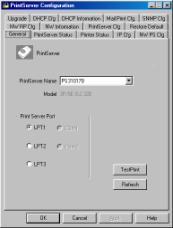
l Every time when you run print server’s configuration utility, the system will initially delay for several seconds because the utility is using system’s available network protocols to search for all print servers on the network. Therefore, you must first select the print server you would like to configure from the Print Server Name’s field under the General tag. The system will, at the same time, display the selected print server’s model number and firmware version.
l You may select any available printer port in the Printer Port’s field at the bottom of that page, and then press the “TestPrint” button to test print.
l By pressing the “Refresh” button, you may manually search again for print servers on the network for you to select a newly added print server.
7.3 Print Server Status
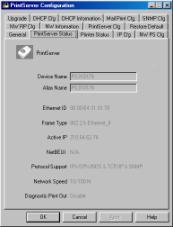
The Print Server Status page displays the network ability and status of the print server in detail.
7.4 Printer Status - Attached Printer Status
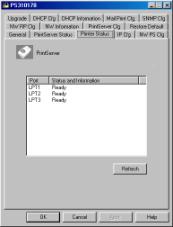
The Printer Status page displays the printer status for each port.
7.5 IP Cfg - IP Address Configuration
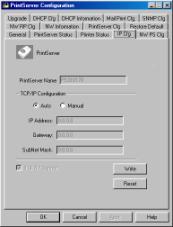
The IP
Cfg page allows you to configure the IP address where the print server
is to be located. The print server will obtain its IP address automatically if
you configure the IP address as Auto.
Click Write button to save the configuration to the print server and Click Reset button to reset the print server and have the changes take effect.
7.6
NW PS Cfg -
NetWare Print Server Configuration
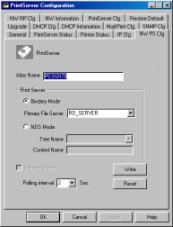
The NW PS Cfg page allows you to set:
l
The Alias name, a nickname by which the print server can be called (in addition to
the PSxxxxxx name printed on the label).
l
The operation mode, which determines how the print server logins to the network
between Bindery mode and NDS mode.
l
The primary file server where the NetWare print server object is located, or the print
server’s NDS tree and context.
l
The remote printer, which determines if the print server works at remote printer mode.
l
The polling interval, which determines how often the print server checks the print
queues.
l
The Write button: save the configuration to the print server.
l The Reset button: reset the print server to let the changes take effect.
7.7 NW RP Cfg - NetWare Remote Printer Configuration
The NW RP Cfg page allows you to set:
l The Print Server, which will be serviced by the print server configured as a remote printer.
l The Printer Number, which is assigned in PCONSOLE.
l The remote printer, which determines if the print server works at remote printer mode.
l The Write button: save the configuration to the print server.
l The Reset button: reset the print server to let the changes take effect.
7.8 NW Information - NetWare Printing Summary
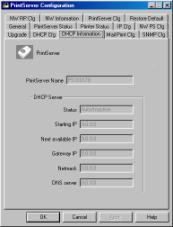
The NW Information page displays the print server connection information for NetWare.
7.9 Print Server Cfg – Print Server Network Ability Setting
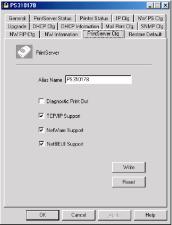
The Print Server Cfg page allows you to set:
l The Diagnostic Printout, which determines whether or not a diagnostic printout should be printed on the printer to which the print server is connected.
l The TCP/IP Support, which determines whether or not TCP/IP network printing is supported
l The NetWare Support, which determines whether or not NetWare network printing is supported
l The NetBEUI Support, which determines whether or not NetBEUI network printing is supported
l The Write button: save the configuration to the print server.
l The Reset button: reset the print server to let the changes take effect.
7.10 Restore Default - Restore to Default

The Restore Default page allows you to erase all of the print server’s settings and restore them to the default settings the print server had when it was shipped from the factory.
l The Restore button: save the default configuration displayed in this page to the print server.
l The Reset button: reset the print server to let the changes take effect.
7.11 Upgrade - Firmware Upgrade / Update
The print server stores its internal programs in “flash” memory, which you can upgrade when new versions of the print server’s software become available or when you want to switch between “Standard Feature Set - Type 1” or “NetWare Enhancement Feature Set – Type 2” -- The difference between these two feature sets is described at Chapter 1.6.(Contact your dealer for information about software upgrades.) To perform an upgrade,
l Make sure the updated PxxxM_xP.BIN (depending on your model) file is stored in your computer or CD-ROM.
l Choose the updated firmware in File Name field. For example,
<CD
Driver>\FLASHROM\<Model Path>\PSxxROM.BIN
l <Model Path> Mapping
PS10M_1P => 10Mbps LAN & 1 Printer Port Model
PS100M_1P => 100Mbps LAN & 1 Printer Port Model
PS100M_3P => 100Mbps LAN & 3 Printer Port Model
l Choose the suitable Feature Set (“Standard Feature Set - Type 1” or “NetWare Enhancement Feature Set – Type 2” ) and then click Upgrade button to upgrade the print server’s flash memory. The yellow Status LED on the print server should be lit continuously.
7.12 DHCP Cfg - DHCP Server Configure
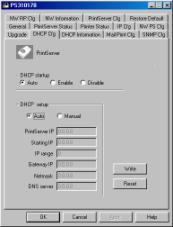
The print server can be configured as DHCP server to provide dynamic IP addresses assignment. The DHCP Cfg page allows you to set:
l
The DHCP startup, which determine if the print server will act as DHCP server. If
this item is set to Auto, the print server will detect if there
is any DHCP server on the network when it boots up. If there is no DHCP server
on the network, then the print server will configure itself as DHCP server;
otherwise it will disable this function.
l DHCP setup is used to configure TCP/IP parameters that will be assigned to a DHCP client. If this item is set to Auto, the print server will determine all TCP/IP parameters automatically; otherwise you will configure the following parameters:
l IP Address: specifies the IP address of print server itself.
l Starting IP: specifies the starting IP address for assigning to DHCP clients.
l IP range: specifies how many IP addresses are available to DHCP clients.
l Gateway IP: gives the IP address of the default gateway.
l Netmask: gives the network mask.
l DNS server: gives the IP address of the domain name server.
l The Write button: save the configuration to the print server.
l The Reset button: reset the print server to let the changes take effect.
7.13 DHCP Information - DHCP Information

The DHCP Information page can be used to display the DHCP server information when the print server is with DHCP server function.
l The status: displays if the print server acts as DHCP server or not.
l Starting IP: displays the starting IP address for assigning to DHCP clients.
l Next available IP: displays the next available IP address that can be assigned to a DHCP client.
l Gateway IP: displays the configured IP address of the default gateway.
l Netmask: displays the configured network mask.
l DNS server: displays the configured IP address of the domain name server.
7.14 Mail Print Cfg - Email Printing Setting
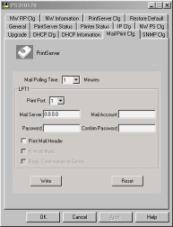
Using print server’s email printing function, the client user on the Internet can email the printing file to a dedicate mailbox, print server will automatically get the email from that mailbox and print it to the attached printer. The detail function description is described in the Email Printing Chapter.
The page allows you to set:
l Mail Polling Time, default value is zero (1 minute). It means the system polling time for getting the email from mail server.
l Mail Server, the mail server IP address of the mailbox located.
l Mail Account, the account of the mailbox in the mail server.
l Mail Password, the password of the mail account.
l Confirm Password, double check the password of the mail account.
l Print Mail Header, which determines whether or not the printing job will print out the mail header.
7.15 SNMP Cfg - SNMP Parameter Setting
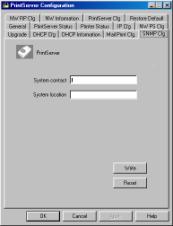
The SNMP Cfg page allows you to configure the SNMP parameters of this print server. These information can be browsed by the SNMP MIB browser.
The page allows you to set:
l System contact, the system Administrator information of this print server.
l System location, the System location of this print server.
8. Web Management
8.1 Introduction
Print server can be configured and managed on the Web. Through Local Area Network, or even Internet, administrator can easily configure and manage print server’s various main functions in browsers. Simply enter print server’s IP address into your browser’s address field to manage a print server by print server’s built-in Web Server.
In addition, in order to increase the convenience of management, print server provides Web Manager Utility to assist you in browsing all print servers and managing print server’s printing environment on your Local Area Network systematically. Please refer to next section for the instructions of Web Manager Utility.
8.2 Web Manager Utility
Web Manager Utility is implemented by WWW Plug-in technology. After the installation of this utility on Windows, you do not need to memorize print server’s IP address nor the number of print servers installed on the same network. After executing Web Manager Utility, all print servers on Local Area Network will be detected by the system automatically and listed in the browser. Simply click on the print server you want to configure to access its built-in web pages.
8.2.1 Installation and Execution
Since Web Manager Utility is a part of Administrator Utility, after installing Windows Administrator Utility, it is already installed. Execute the “Web Manager Administrator” in the program folder “Print Server Utilities”.
8.2.2 Starting Web Manager Utility
When you execute Web Manager Utility, system will display print server Web Console Page for approximately 5 seconds. At the mean time, system will be searching for all print servers on the same subnet.
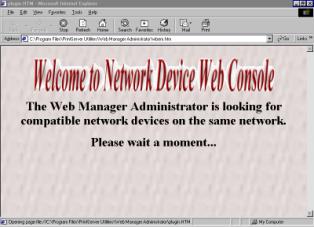
After searching is completed, the screen will be switched to the following:

The Window will be split into two parts:
l Print Server List on the left portion, which lists all print servers found on the same network.
l Web Pages for the selected print server on the right portion, which displays the configuration information for the print server.
In the left frame, click on the print server that you want to manage and configure, then the print server’s Web configuration screen will be displayed in the right frame. Instead of executing Web Manager Utility, you may also directly enter print server’s IP address into the address field of any browser to display its Web management screen. The only difference is that the list in the left frame will not be displayed.
8.3 Web Management of Print Server
8.3.1 Using Browser
You may use any Web Browser to review the status or configure the settings of the print server. Print Server’s management screen contains three frames:
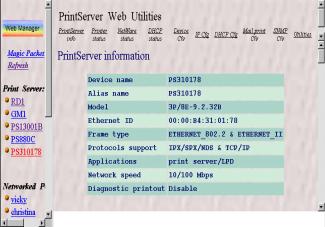
l Control Panel :
On the top, which contains several HyperText links that links to a information or configuration page respectively.
l Status Line :
On the bottom, which is used to display warning or error message.
l Configuration Pages :
In the middle, which contains several information pages about print server and its attached printer(s), and several configuration pages used to set up print server.
The browser will group the configuration items into the following topics,
l Print Server Info: General Information of print server.
l Printer Status: Current status of the attached printers.
l NetWare Status: Print Server connection information of NetWare
l DHCP status: Current DHCP server status and information.
l Device Cfg: Device configuration
l IP Cfg: IP configuration
l DHCP Cfg: DHCP paramater configuration
l Mail Print Cfg: Email printing configuration
l SNMP Cfg: SNMP Information configuration
l Utilities: Some utilities for print server
In order to protect your print server, you can get all information pages at any time you like, but you can not save the configuration pages before password verification. You will be asked to check username and password when you want to save a configuration page and you have not been verified yet. Please ignore the username and enter password at that moment and reload the configuration pages again. The configuration pages will now be displayed in the browser window.
8.3.2 Getting Print Server Information
Each time you run browser to connect to a print server, you will get this print server information page initially. The print server information page displays some general information of print server.
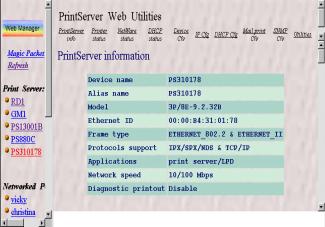
8.3.3 Getting Printer Status
The Printer status page can be used to display the status of attached printer(s) for each port.
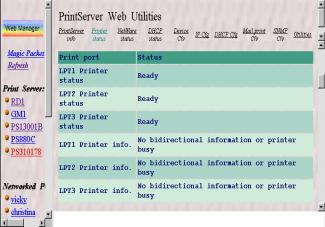
8.3.4 Getting NetWare Information
The NetWare status page displays the NetWare connection information of the print server.
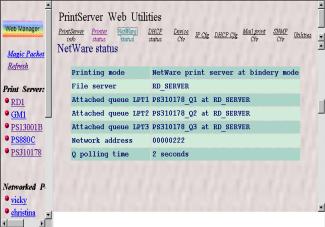
8.3.5 Getting DHCP Status
The DHCP status page can be used to display the DHCP information when the print server’s client DHCP function is enabled.
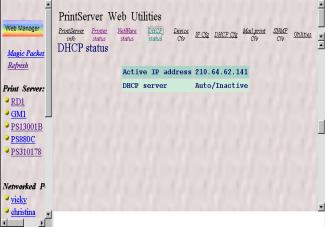
8.3.6 Changing Device Configuration
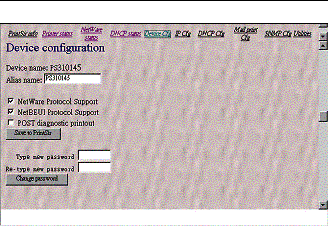
The Device Cfg page allows you to set:
l Alias name, an alternate name by which the print server can be called (in addition to the PSxxxxxx name printed on the label).
l NetWare Protocol Support, which determines whether or not the print server support NetWare printing function.
l NetBEUI Protocol Support, which determines whether or not the print server support NetBEUI network protocol.
l POST diagnostic printout, which determines whether or not a diagnostic printout should be printed to the attached printer.
l Save to Print Server button: save the configuration to the print server.
l Type new password, change to new password.
l Re-type new password, confirm the new password.
l Change password button: save the new password to the print server.
The print server will verify your password (it will ignore the User Name item) when you save the configuration.
Make sure to reset the print server (described in section 8.3.11 System Utilities ) to let the changes take effect.
8.3.7 Setting IP Address

The IP Cfg page allows you to configure the IP address where the print server is to be located. The print server will obtain its IP address automatically by the protocol DHCP, BOOTP, RARP if you configure the IP address as Auto. Click Save to print server button to save the configuration to the print server.
The print server will verify your password (it will ignore the User Name item) when you save the configuration. Make sure to reset the print server (described in section 8.3.11 System Utilities ) to let the changes take effect.
8.3.8 Configuring DHCP Parameters
The print server can be configured as DHCP server to provide dynamic IP addresses assignment. The DHCP Cfg page allows you to set:
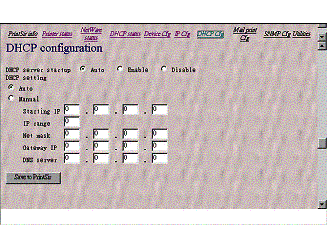
l The DHCP server startup, which determine if the print server will act as DHCP server. If this item is set to Auto, the print server will detect if there is any other DHCP server on the network when it boots up. If there is no DHCP server on the network, then the print server will configure itself as DHCP server; otherwise it will disable this function.
l DHCP setting is used to configure TCP/IP parameters that will be assigned to a DHCP client. If this item is set to Auto, the print server will determine all TCP/IP parameters automatically; otherwise you will configure the following parameters:
q Starting IP: specifies the starting IP address for assigning to DHCP clients.
q IP range: specifies how many IP addresses are available to DHCP clients.
q Net mask: gives the network mask.
q Gateway IP: gives the IP address of the default gateway.
q DNS server: gives the IP address of the domain name server.
l The Save to Print Server button: save the configuration to the print server.
Make sure to reset the print server (described in section 8.3.11) to have the changes take effect.
8.3.9 Configuring E-Mail Printing
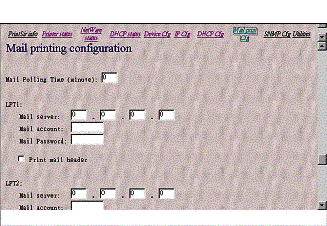
Using print server’s email printing function, the client user on the Internet can email the printing file to a dedicate mailbox, print server will automatically get the email from that mailbox and print it to the attached printer. The detail function description is described in the Email Printing Chapter.
The page allows you to set:
l Mail Polling Time, default value is zero (1 minute). It means the system polling time for getting the email from mail server.
l Mail Server, the mail server IP address of the mailbox located.
l Mail Account, the account of the
mailbox in the mail server.
l Mail Password, the password of the
mail account.
l Print Mail Header, which determines
whether or not the printing job will print out the mail header.
8.3.10 Configuring SNMP Parameters
The SNMP Cfg page allows you to configure the SNMP parameters of this print server. These information can be browsed by the SNMP MIB browser.

The page allows you to set:
l System Contact, the system Administrator information of this print server.
l System Location, the System location of this print server.
8.3.11 System Utilities
You can perform several tasks from this Utilities page, as described below:
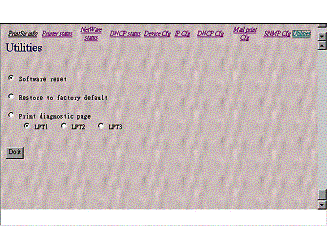
l The Software reset: which determines whether or not to reset the print server.
l The Restore to factory default: which determines whether or not to erase all of the print server’s setting and restore to the default configuration the print server had when it was shipped from the factory.
l The Print diagnostic page: which determines whether or not to print a diagnostic page to a attached printer connected at either LPT1, LPT2 or LPT3 of the print server. This feature can be used to test the print server to make sure it is operating properly, or to isolate any installation problems.
l The Do it button: do the action specified in the above.
9. Email Printing
9.1 Introduction
Email Printing provides a new way of printing service. After installation, Windows will establish a new Printer Driver which will convert the printing document to an Email and send to the mail account assigned by print server. Print server will periodically retrieve Emails in the mail account and print it to the attached printer directly.
9.2 System Requirement
9.2.1 Print Server Side
Print server must be connected to an Email server that provides an Email account for the print server. At the meantime, the Email server has to permanently connect to the Internet for receiving user's email printing documents.
9.2.2 Client Side
q Client side can be any operating systems with a mailing tool.
q Client Side must be able to connect to an SMTP Email server for sending email.
q Client Side must install and setup TCP/IP protocol for Internet connection.
q If you use the first printing service described in the next section, please install the Printing Driver for Email Printing provided in the CD-ROM.
9.3 System Setup
9.3.1 Print Server Side
Step1.Execute the Print Server Configuration Utility。
Step2.In the IP Cfg page, configure the IP address.
Step3.In the Mail Print Cfg page,configure Mail polling time and MailBox parameters.
Mail Polling Time : Default is 1 minute; Intervals for print server to check Emails in the MailBox.
Mail Server, Mail Account and Password are MailBox's Email server's IP address, account, and password respectively.
Step4. Press "Write" then "Reset" button.
9.3.2 Client User Side
At first, please confirm that the client computer has installed and setup the TCP/IP protocol correctly.
Email Printing provides three printing methods, the insructions and installation are described below:
9.3.2.1 Print directly from appclitions by using the “Print to Email printing driver”
At first, the client user needs to install and setup the “Print to Email Printing Driver” from the CD-ROM shipped with the print server package. You can deliver the “Email Printing Driver” to any one who will print email from its Windows to your printer. The “Email Printing Driver” is implemented as a freeware that can be shared with every one. Please note that the “Email Printing Driver” is designed for Windows only, it can’t be run on any other operating systems.
The installation procedure is as following,
1. Insert the CD shipped along with the print server into your CD-ROM drive. Change the directory to “\Email Printing\English\”
2. Execute “setup.exe” program
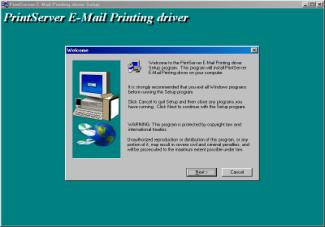
3. Click “Next” and choose a installation path or use the default,
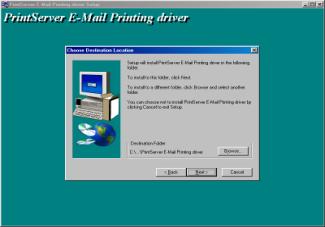
4. Click “Next” and assign a program folder name,
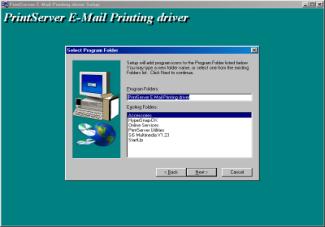
5. Click “Next” and the system will install the “Email Printing Printing Driver”.
After the installation is completed, you need to configure the Printing Driver of Email Printing as following,
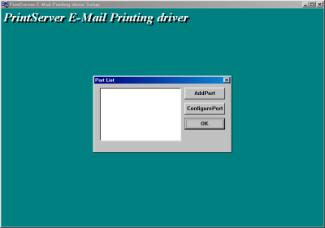
6. Click the “AddPort” Buttom, and you can see the following dialog box,
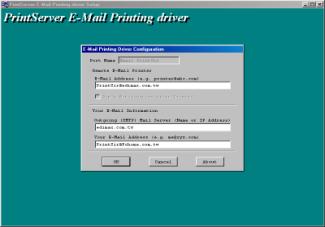
7. Please input the proper value in the fields described as following,
Port Name: The Printer Port Name for Email Printing. It will be used when you execute the “Add Printer”
E-Mail Address: The email address serviced by the print server.
Outgoing Mail Server: The mail server of your client computer for sending the email.
Your E-mail address: The information which will be printed at the header of the printing document.
8. Click OK and complete the “Email printing driver” installation procedure.
You can then perform the Windows’ standard “Add Printer” command and choose the Email Printer Port Name assigned in the above procedure. Please refer section 3.4 for detail “Add Printer” procedure.
9.3.2.2 Directly send an Email to the email account serviced by the print server.
For a client user who want to print a text email to the printer attached by the Print Server but without the “Email Printing Driver”, he (or she) can, just as usual, run the mailing tool, key in the content and send the email. Please note that the email recipient should be the email address serviced by the Print Server. The Print Server will automatically retrieve the email from the email box and print to the attached printer.
9.3.2.3 Send an Email with an attached document to the email account serviced by the Print Server
For a client user who wants to print a document to the printer attached the Print Server but without the “Email Printing Driver”, he (or she) can first print the document to a file and send this document file as an email attachment to the email account serviced by the Print Server. The detailed procedures are described as below:
l Run the application, open the document and select the “Print” function.
l After the Print dialog box appears, click the “Print to File” check box and enter a file name to be saved, then a printing file will be created. The printing file on Windows is with the file extension “.prn”
l Run the mailing tool, create a new email, attach the newly created printing file and enter the Email address serviced by the Print Server, then send out the email. The Print Server will automatically retrieve the email from the email box and print the attachment to the attached printer.